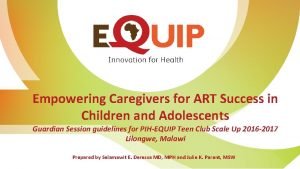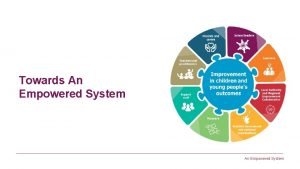Are Indian working women empowered Presented at XI









- Slides: 9

Are Indian working women empowered? Presented at XI Eurasian Economic Youth Forum Ural State University of Economics (Yekaterinburg), Russia April 21 -23, 2020 Leena Mary Eapen Indian Institute of Management Kozhikode, Kerala, India leenaeapen@iimk. ac. in

Introduction • Empowerment is a process by which women gain greater control over material and intellectual resources thereby enhance their self-reliance and independent rights to challenge the gender-based discrimination against women. • There are mainly three direct indicators of empowerment (i) Decision making power; (ii) Control over economic resources; and (iii) Freedom of movement

Empowerment at the Household • Though a household is considered to be a single entity, the preferences or priorities of household members may differ (Marilyn Manser and Murray Brown 1980). • If households are harmonious and all household members share similar likes and desires, then the outcomes of decision making would be the best, irrespective of who makes the decisions (Esther Duflo 2012). • But as the preferences of husband wife differ, their differential decision making power would affect outcomes (Cheryl R. Doss, 1996; Takayoshi Kusago and Bradford L. Barham 2001). • Each household member has particular decision-making power depending on her/his access to information set and status in the home. • Decision-making power at the household level has a major influence on individuals’ roles and positions in society at large.

Data and Objectives of the study • To assess who makes decisions at the household level and whether women have empowerment through education and a paid job outside the house. • We would expect that as women started earning, higher will be their decision making power, freedom of mobility and control over resources. • This study is based on a 100 household survey undertaken in the India city of Kozhikode located in the state of Kerala. The study used a pre-tested structured questionnaire. • Kerala has the highest literacy rate compared to other states in India and one among the top on social development indicators. The study population comprised of married women in the age group 22 -55 who live with their husband all are currently working in a paid job. Profession Teachers Doctors Engineers Officers Accountant/clerk Executives Total Number of Respondents 32 25 10 10 18 5 100

Conceptual framework • This study is based on Naila Kabeer’s (1999) three principal elements of empowerment and examines whether women in India with resources such as education, earnings, and professional engagement are adequately empowered. resources (preconditions) agency (process) achievements (outcomes ) • Education, professional engagement and income earned as resources. • Ability to choose and participate in decision making as the agency. • Decision-making, freedom of mobility and control over the financial resources as outcomes.

45 43 40 Daily Household Purchases 35 Festival Celebrations 33 30 25 25 24 21 22 20 15 10 5 8 5 0 Husband as sole decision maker In-laws as a part of decision making women as sole decision maker Collective decision

Items Percentage of women reported as Joint decision making Number of Children 88. 37 Birth control Buying clothes for children 84. 34 Naming Children Selection of Children's school 79. 55 Education of children Taking Children to doctor 69. 32 Health of children 64. 04 82. 35 76. 74 67. 44

Freedom of Mobility Utilisation of resources

Conclusions • A higher education level and working outside the home helped the women to participate in almost all the decision making at the household level. • It is found that women played an active role in decision-making processes, but if disputes arise in the case of major decisions, men’s decision matters. • Wives and husbands were equal partners in child-rearing. • Earning their own income did not guarantee that women had financial independence in the household and freedom of mobility. • These findings imply that having resources helped the process as an agent but still the outcomes are not always as desirable. • Cultural factors like moving to in-laws’ homes undermined women’s empowerment. • The society requires the cohort groups could promote an equal partnership among husband wife rather than a hierarchical or subordinate system at the household level.

















